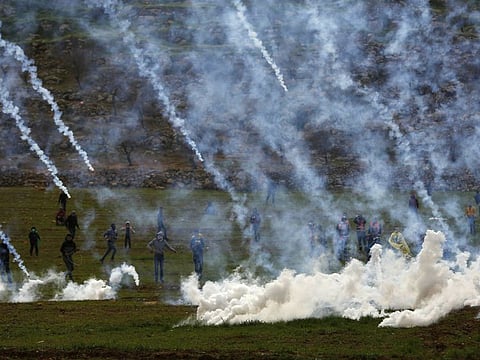Attacks by Jewish colonists surge in the West Bank
Israel has lifted restrictions which helped curb Jewish extremism in the past

Al Mughayyir, Occupied West Bank: A gang of a dozen or so armed Jewish colonists descended from a hilltop illegal outpost to the Palestinian village below and opened fire, witnesses said.
Israeli occupation soldiers arrived, and instead of stopping the colonists, the witnesses said, they either stood by or clashed with the villagers.
In the melee, Hamdy Naasan, 38, a Palestinian father of four, was shot and killed.
The killing last month was the latest in a wave of colonist violence. Attacks by colonists on Palestinians, their property and Israeli occupation forces increased by 50 per cent last year and have threatened to ignite the Occupied West Bank, Israeli occupation officials say.
Days earlier, the Israeli authorities charged a 16-year-old yeshiva student from another Jewish colony with manslaughter and terrorism, accusing him of hurling a 4-pound rock that killed Aisha Al Rabi, a Palestinian mother of eight, one night in October as she rode in her family car along a nearby highway.
While Palestinian and United Nations officials have condemned the violence—Nickolay Mladenov, the UN envoy to the Middle East, described the shooting in Al Mughayyir as “shocking and unacceptable”, Israel’s right-wing government has remained conspicuously silent.
In 2015, after a Palestinian home in the village of Duma was firebombed in 2015, killing a toddler and his parents, Netanyahu and right-wing leaders issued strong condemnations and said Jewish terrorism would not be tolerated.
This time the loudest voices have risen to the defense of the Jewish suspects. Palestinian President Mahmoud Abbas blamed the Israeli government for allowing the situation to escalate.
“This is a continuation of Israeli policy and will lead to further tension and create an uncontrollable atmosphere,” he said.
Israeli officials partly attribute the surge in colonist violence to the recent lifting of restrictions from some main extremists.
Authorities had imposed anti-terrorism measures after the 2015 Duma attack and the subsequent exposure of a shadowy militant network known as “the Revolt.”
The group seeks the collapse of the state of Israel and its replacement with a Jewish kingdom based on religious law.
The extraordinary steps included administrative detentions and orders keeping key radicals out of the West Bank.
Those temporary orders have now run out which explains the surge in Jewish terrorism.
Residents of Al Mughayyir said armed colonists first came down the hill and vandalised a tractor, smashing its windows and puncturing its tires.
Farmers ran to ask some soldiers stationed nearby for help, but the soldiers told them to call the police.
Naasan’s cousin, Yasser Naasan, 34, said he went to check on the tractor but more colonists arrived, fired at him and chased him back to the village.
The mosque loudspeakers called on residents to come out and defend their homes.
Palestinians threw stones.
Witnesses said occupation soldiers arrived and fired tear gas, stun grenades, rubber bullets and possibly live bullets in the air while colonists shot live ammunition.
One resident showed photographs on his cellphone of armed colonists standing shoulder to shoulder with soldiers, and some colonists wearing masks.
“I witnessed a battlefield,” said Farraj Naasan, 53, an uncle of Hamdy Naasan.
“There was massive shooting. Ta-ta-ta. I saw three Israeli soldiers firing into the air and three colonists firing directly at people.”
Hamdy Naasan worked in construction and spent seven years in an Israeli prison for security offenses. He was released in 2008. Last Saturday, his uncle said, he was helping evacuate the wounded.
“He carried the first and the second,” he said. “When he went up to get more of the wounded, he was shot.”
Naasan fell about 50 yards from the last home on the edge of the village.
Another witness, Samir Abu Alia, 53, said villagers had to wait 20 minutes, until the shooting subsided, to retrieve his body.
Sign up for the Daily Briefing
Get the latest news and updates straight to your inbox



